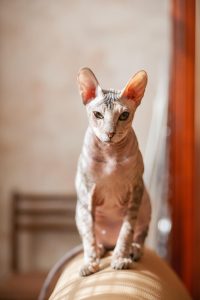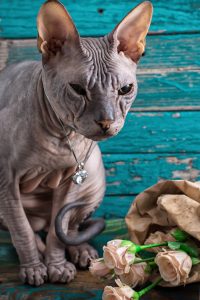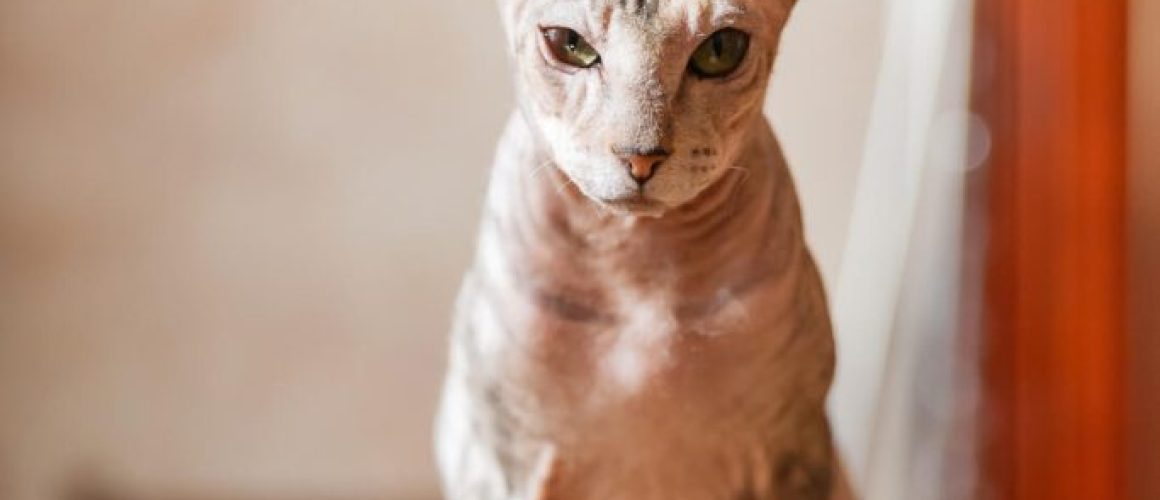8 Breeds of House Cat With No Hair – No More Hairy Clothes!
These charismatic felines result from spontaneous genetic mutations, with hairless to fuzzy, felt-like skin. You might be thinking of getting a hairless cat, which would be a great idea if, for example, you are allergic to cat hair.
Sphynx
Sphynx cats are affectionate pets that form strong bonds with their humans. When you arrive home, your sphynx will usually greet you by greeting the door as you come through and will enjoy spending time in your home with other people and pets alike.
Sphynxs are known for being playful, intelligent, and highly social animals. With outgoing personalities that thrive at entertaining others and possessing curious yet mischievous tendencies, Sphynxs make great companions for families with children or other animals. Furthermore, their hairless coat provides warmth when playing outside in cold climates, making them highly affectionate companions.
Though Sphynx cats may appear completely hairless, their skin is covered with a dense layer of fuzz similar to suede; this fur may come in solid or multicolor patterns, including tabby and tortoiseshell patterns. Additionally, whiskers and eyelashes may or may not exist – some cats even don’t!
Sphynx cats’ lack of fur necessitates having regular baths with mild shampoo to keep their skin clean and free from excess oil build-up. You need to ensure they are kept in a warm, dry environment to regulate temperature and prevent heatstroke or dehydration. Furthermore, since Sphynx cats frequently develop digestive issues, frequent veterinarian visits with coverage from insurance plans like Petplan can cover costs related to treating those issues.
Peterbald
Peterbald cats stand out with their triangular heads, large ears, and long bodies – making them truly elegant pets. Intelligent and curious, Peterbald cats love exploring new environments while at the same time taking comfort in being indoor pets – they make great companions as they get along well with other animals as well as people of all ages!
Peterbald cats do well indoors, climbing cat trees and playing with toys before cuddling close to their humans while watching television. Since these cats lack fur to regulate temperature, extreme temperatures may present difficulties; to maintain healthy skin, they should be bathed daily with antibacterial soaps or wipes and bathed again every 1-3 days for bath time and wipe-downs.
Hairless cats such as Peterbalds tend to have high energy levels and may become easily overstimulated; their owners should consult a veterinarian about proper feeding schedules – Typically, these felines require higher-protein diets than other felines.
Donskoy
Donskoy (Ukrainian Levkoy) cats are an elegant cross between Donskoy cats with Scottish Folds and Orientals that result in distinct folded ears similar to Sphynx cats. Unfortunately, most international cat registries do not recognize it as an officially recognized breed.
These cats can be very affectionate and needy, preferring the company of people they know and playing together. Although smart enough to learn leash walking, these felines only tolerate being left alone for extended periods – with enough interaction. They may become depressed.
Donskoys do best when kept indoors as their bodies quickly overheat when exposed to direct sunlight for too long, and their delicate skin may be susceptible to sunburn. Regular baths and wipe-downs help them remain healthy, avoid skin issues, and help avoid gum disorders or thickening of heart muscle fibers over time.
Ukrainian Levkoy
The Ukrainian Levkoy cat breed is relatively new to the hairless cat scene. Although not recognized by major international cat associations, its stunning looks, friendly demeanor, and cute folding ears have quickly made it one of pet owners’ top choices.
This breed makes an excellent companion and thrives in homes with both children and other animals, being highly intelligent with strong bonds formed between themselves and people and other pets. They are affectionate, though stubborn enough to ignore calls from their owners when rest would be preferable.
Levkoy cats stand out with their distinct doglike features. Their ears resemble leaves from a Levkoy plant and fold inward towards their heads for a unique appearance, often featured in horror films and video games! Though these friendly felines enjoy spending time with their families, extended periods alone may cause depression or anxiety.
Elf Cats
Elf cats are new hairless breeds created by breeding Sphynx cats with American Curls. However, these social felines thrive in stimulating social settings as they require more daily calories due to being more energetic than other breeds.
This hybrid breed may still be relatively rare, yet it has left an indelible mark on cat society and is characterized by wrinkled skin and curled ears – much like human wrinkles! Although this cat breed may produce some dander, its unique characteristics set them apart.

Are You Thinking About Adopting an Elf Cat? Experienced Veterinarians Can Be Key When Adopting Elf Cats, those considering adopting this breed must find an experienced veterinarian that understands its unique health requirements, such as ear infections and temperature regulation issues, oil build-up issues, frequent bathing needs and feeding them (ideally 5 percent of their body weight every day).
Bambino
This exquisite hybrid between hairless Sphynx and short-legged Munchkin breeds, the Bambino, is an endearing cat with a charming personality. Engaged yet affectionate, this playful yet loving breed thrives off human interaction, preferring not to spend too much time alone, making this breed an ideal companion for families with young children.
No matter their shorter legs, these cats remain highly energetic and agile. They love playing with toys and enrichment forms for cats, especially jumpers like these breeds can quickly scale low cat trees. Unfortunately, due to their shorter legs tiring more rapidly than expected, it is recommended to keep these cats indoors or away from higher surfaces.
Though baby cats generally lead relatively healthy lives, it is still essential that they receive routine wellness exams from a vet. Without fur to absorb natural oils from their environment, their skin can quickly become oily or dry; plus, due to their small chests and miniature bodies, they may be susceptible to respiratory issues that need treating regularly; also, their small mouths could develop dental problems without professional cleanings regularly – something which grooming and diet can prevent.
Minskin Cat Breed
Though relatively new, this breed has gained widespread acceptance due to its distinctive features and charming personalities. This hairless cat sports fur points on its ears, mask, tail, and legs for an adorable appearance, while its skin features cashmere-like textures with a soft sheen for extra luxury.
The Minskin cat breed is an affectionate, social companion who thrives off human interaction and socialization, getting along well with dogs and other cats. Unfortunately, its constant grooming requirements and separation anxiety issues make this cat unsuitable for people who spend much time away from home.

Minskins require a warm and cozy environment to thrive as indoor pets. Their thin skin must be kept clean to prevent yeast infections or rashes; toys that keep them active are also necessary if you want your Minskin to remain contented and happy. Since they are predatory breeds, ensure their diet includes plenty of high-quality dry or wet food from brands recommended by veterinarians – we suggest feeding high-quality dry or wet food from such brands.
Canadian Hairless
Canadian Hairless, commonly called the “Naked Human,” is an unusual twist on the most widely recognized Sphynx breed. Although both have no fur, Xherdan, a three-year-old specimen from Vancouver, stands out. His skin features more prominent wrinkles, giving him a distinctive texture and appearance, earning him the “Naked Human” moniker.
This breed gained notoriety in 1966, similar to its Sphynx counterpart before officially being recognized by the Cat Fanciers’ Association as an individual show cat breed in 2002. Both species of hairless cats are great options for mild allergy sufferers; however, Canadian Hairless Cat’s saliva seems less likely to trigger specific individuals.
Personality-wise, Xherdan epitomizes his breed’s social tendencies. Always curious, he can often be found sniffing around cupboards, boxes, and bags around the house – “he wants to be part of everything going on,” according to owner Jani Martinka. His trainability and responsiveness to voice commands make him an ideal family pet who gets along well with children and dogs!
Special care must be given to his skin; unlike the Sphynx, which accumulates oils over time, Canadian Hairless Cats require less frequent baths due to being less oil-prone. However, due to their heat sensitivity, ambient temperature regulation remains essential in providing comfort.
